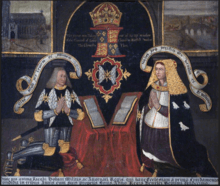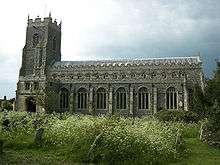James Hobart

Sir James Hobart, also known as James Hoberd and James Hubbard, (1436[1]-February 24, 1517[lower-alpha 1]) of Norfolk became a member of Lincoln's Inn during Edward IV of England's reign and was appointed attorney-general and knighted during the reign of Henry VII.[2]
Career
Hobart became a member of Lincoln's Inn during Edward IV's reign. He performed some legal services for John Mowbray, duke of Norfolk and is likely the James Hoberd who went to parliament in 1467 and 1478, representing Ipswich. Hobart was elected Lent reader at his inn in 1479.[2]
Henry VII appointed him attorney-general on 1 November 1486. He then became a member of the privy council.[2] Hobart was one of the men appointed to seize Calais for Henry VII and take possessions of the king and other townspeople.[2][9]
Hobart assumed several responsibilities in 1487. He was made commissioner of array for Norfolk in April. Hobart, and others, were appointed to oversee the fisheries on the east coast. He also supervised the repair of the harbour in Yarmouth.[2] He served on two commissions in 1489. One for gaol delivery for Ipswich and Norwich and the other for peace and oyer and terminer for Suffolk.[2] Hobart was appointed to try a suit at York, when he is styled serjeant, in August 1501. He was knighted on 18 February 1502–3 by Henry, prince of Wales.[2]
Hobart left the attorney general office in 1507 following a controversy involving writs of praemunire facias.[8]
Personal life
James was the youngest son of Thomas Hobart of Leyham in Norfolk.[2] Hobart married three times. John Lyhert's sister, Margery, was his first wife. The second was Dorothy Glemham.[8] Margaret Naunton, the daughter of Peter Naunton of Letheringham, Suffolk, was his third wife. She died in 1494.[2]
Hobart lived at his home, Hales Hall in Norfolk.[2] He was a good friend of John Paston and is often mentioned in the Paston Letters.[2]
Hobart's chest-tomb is located in the nave of the Norwich Cathedral.[10] His great-grandson was Sir Henry Hobart, the chief justice.[2]
Holy Trinity Church
Hobart erected "at his sole expense" the Holy Trinity Church at Loddon in 1490.[11] A stained glass artwork, removed from the east window of the church and preserved as a painting, shows Hobart and Lady Margaret Hobart in prayer.[1] A caption in Latin beneath them reads, Orate pro aia Jaci Hobart, milit. & attornati dmi regis, qui Hanc ecclesiam a primis fundamentis condidit in tribus annis cum suis propriis bonis, anno regis Henrici septimit undecimo. Roughly, it translates as "Pray for James Hobart, soldier and attorney general to the King, who contributed to the foundations of the Church in the eleventh year of King Henry VII."
Notes
- ↑ The Dictionary of National Biography (1891) and other sources cite Hobart's death as in 1507,[1][2] but Colin Richmond (2005) notes that his will was drawn up on July 27, 1516 and that he died in 1517.[3] The confusion may be due to the statement from the DNB, which says "He continued in his office until his death in 1507.[2] And, that there was a sudden resignation as attorney general by Hobart in 1507.[4][5] But, Steven Gunn states that he resigned in 1507 and died ten years later,[6] which synchs up with Richmond's mentioning of his 1516 will and 1517 death[3] and others, like Gibson, who say that he died in 1517.[7] Moreover, the Oxford Dictionary of National Biography provides the death as February 24, 1517.[8]
References
- As of this edit, this article uses content from "Hobart, James (DNB00)", which is licensed in a way that permits reuse under the Creative Commons Attribution-ShareAlike 3.0 Unported License, but not under the GFDL. All relevant terms must be followed.
- 1 2 3 Art UK. "A Copy of the East Window in Loddon Church, with the Kneeling Figures of Sir James Hobart (1436–1507), PC, MP, JP, and His Third Wife, Margaret Naunton (d.1494), Lady Hobart, the Widow of John Dorward". Art UK. Public Catalogue Foundation. Retrieved November 19, 2016.
- 1 2 3 4 5 6 7 8 9 10 11 12 13 14 Williams, James (1891). "Hobart, James (DNB00)". Dictionary of National Biography, 1885-1900. 27. Smith, Elder & Co. p. 31.
- 1 2 Richmond, Colin (2005). John Hopton: A Fifteenth Century Suffolk Gentleman. Cambridge: Cambridge University Press. p. 190.
- ↑ Chrimes, S.B (July 11, 1999). Henry VII. Yale University Press. p. 14. ISBN 978-0-300-21294-5.
- ↑ Dalton, Hannah; Fordham, Michael; Smith, David (February 4, 2016). A/AS Level History for AQA The Tudors: England, 1485–1603 Student Book. Cambridge University Press. p. 14. ISBN 978-1-316-50432-1.
- ↑ Gunn, Steven (June 9, 2016). Henry VII's New Men and the Making of Tudor England. Oxford University Press. p. 286. ISBN 978-0-19-965983-8.
- ↑ Gibson, Gail McMurray (January 1989). The Theater of Devotion: East Anglian Drama and Society in the Late Middle Ages. University of Chicago Press. p. 196. ISBN 978-0-226-29102-4.
- 1 2 3 Ives, E. W. (2008). Oxford Dictionary of National Biography. Oxford: Oxford University Press.
- ↑ Campbell, William (November 15, 2012). Materials for a History of the Reign of Henry VII: From Original Documents Preserved in the Public Record Office. Cambridge University Press. p. 356. ISBN 978-1-108-04910-8.
- ↑ Atherton, Ian (1996). Norwich Cathedral: Church, City, and Diocese, 1096-1996. A&C Black. p. 479. ISBN 978-1-85285-134-7.
- ↑ Britton, John; Brayley, Edward Wedlake (1810). Topographical and Historical Description of Norfolk: Containing an Account of Towns, Castles, Antiquities, Churches, Monuments, Public Edifices, Picturesque Scenary, the Residences on Nobility, Gentry, Etc., Accompanied with Biographical Notices of Eminent and Learned Men to Whom this Country Has Given Birth. London: Sherwood, Neely, and Jones. p. 205.
